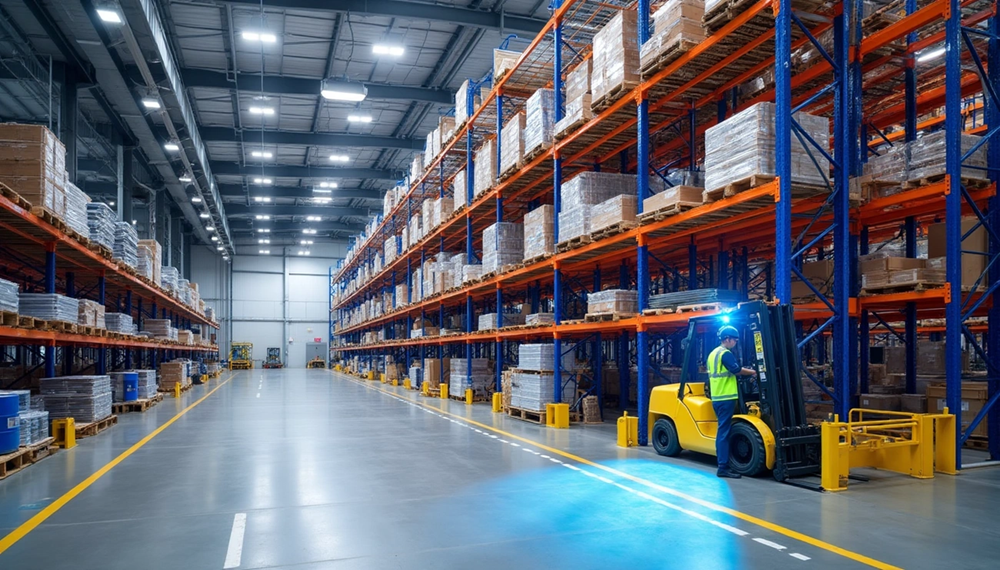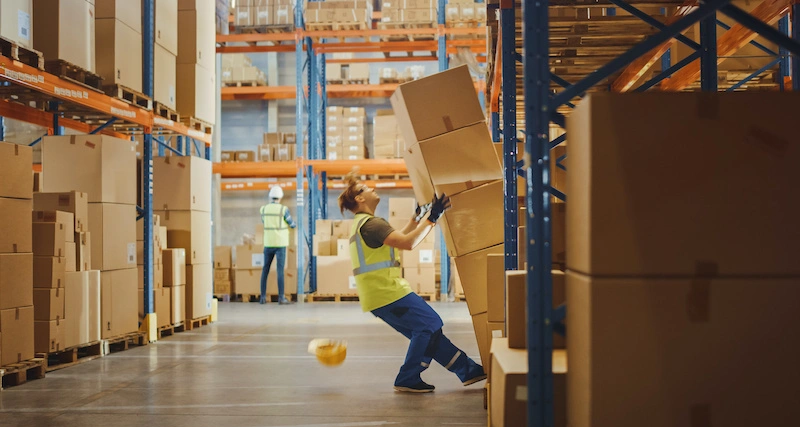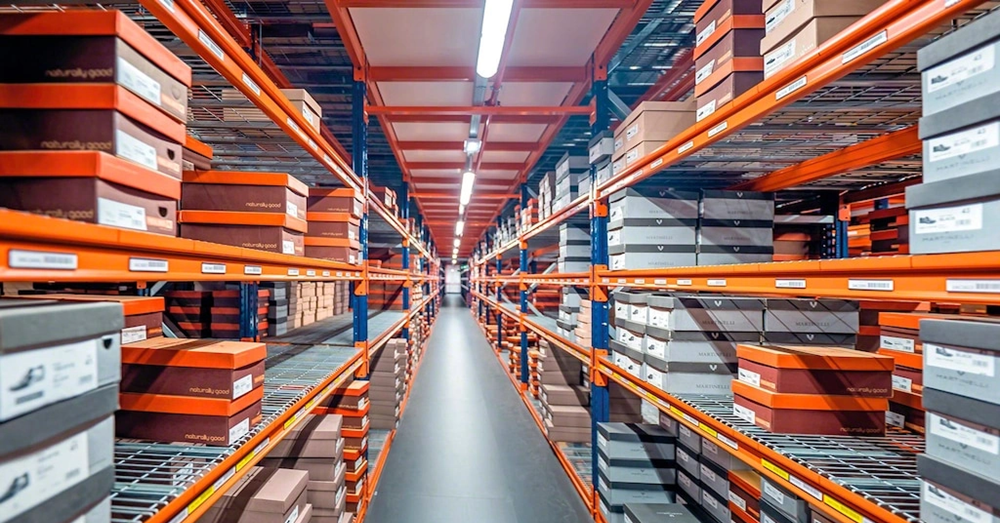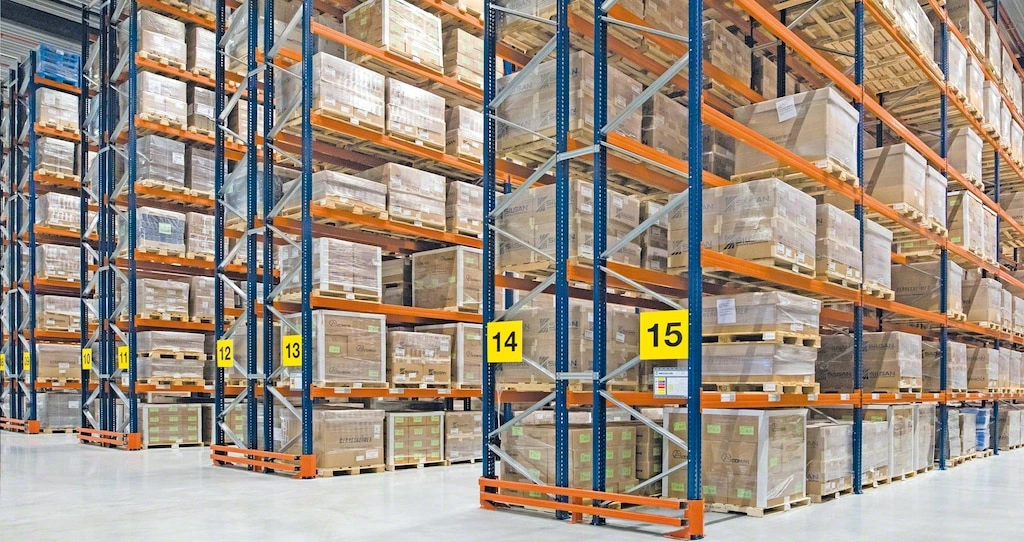
Industrial storage racks help prevent devastating warehouse accidents and maximize storage efficiency. Specialty racks maximize storage density and improve safety by a lot in the warehouse. Modern warehouse racking systems provide the structural integrity needed to prevent dangerous collapses and falling inventory with heavy-duty uprights that support up to 28,300 lbs.
Our team has seen how proper warehouse storage racks change disorganized spaces into safe, efficient operations. Heavy-duty steel shelving, wide span storage racks, and bulk storage racks provide flexible solutions for different storage challenges. A business’s investment in proper storage racking systems is a vital step to protect both personnel and products.
This piece will get into common warehouse hazards and show how industrial storage racks improve safety. You’ll learn about eight specific rack types that prevent accidents. The guide also includes best practices to install and maintain your racking system safely for years ahead.
Common Warehouse Hazards Without Proper Racking

American warehouse workers faced a staggering 144,000 injuries that required time off work in 2021-2022. These numbers rise even higher without proper industrial storage racks in place. Let’s get into the most common dangers that show up in poorly organized storage areas.
Falling inventory due to unstable stacking
Stacking materials incorrectly creates dangerous safety hazards that can crush workers or even kill them. Warehouses without good storage rack systems see items stacked loosely or unevenly, which makes them unstable and likely to collapse. The risk becomes worse when workers place heavy items up high instead of near the floor.
Overloaded shelves create some of the most serious threats to warehouse safety. The structure becomes unstable and puts both employees and inventory at risk of damage. It also creates situations where unsecured items on badly installed industrial warehouse shelving can fall and hit workers below, which makes up about 10% of non-fatal workplace injuries.
Blocked aisles and emergency exits
Clear pathways can save lives at the time of emergencies. Workers need continuous and unobstructed paths from any point in the workplace to safety. These blocked aisles and cluttered exits then become some of the most dangerous warehouse safety hazards.
OSHA rules clearly state that exit routes must stay “free and unobstructed” without any materials placed in these critical pathways, whether temporary or permanent. Exit routes must also avoid rooms that can be locked, like bathrooms or paths that lead to dead ends.
Manual handling injuries from poor access
About 20% of non-fatal workplace injuries come from handling, lifting, and carrying materials. Poor access from inadequate industrial storage racks forces workers into awkward positions that can hurt them. Workers often need to twist, reach, and stoop to get materials from badly designed storage areas.
Manual handling becomes especially dangerous when:
- Workers must keep moving boxes on and off racks with force
- They need to grip heavy or bulky items without proper handles
- Storage design makes them bend and twist to lift heavy materials
Industrial storage racks substantially cut down these hazards by organizing materials properly and making them easy to access. This works best when the racks let most workers handle materials between mid-thigh and shoulder height.
How Industrial Storage Racks Improve Safety

Industrial storage racks come with essential safety features that help prevent the hazards we discussed. These systems use smart design and special components that work together to keep warehouses safe.
Load distribution in heavy-duty industrial storage racks
The way loads are distributed plays a key role in warehouse safety. Heavy-duty industrial storage racks work best when weights are spread evenly across both beam sets to match their capacity ratings. Uneven distribution of weight can cause dangerous structural problems.
Most racks fail because they are either overloaded or loaded incorrectly. Warehouse managers should know these four main types of loads:
- Uniformly Distributed Loads (UDL) – Weight spreads evenly across beams (ideal scenario)
- Line Loads – Weight focuses along specific lines (like paper rolls)
- Point Loads – Weight concentrates on small contact points
- Concentrated Loads – Items that don’t reach supporting beams
Each rack system needs clear signs showing load limits to stop dangerous overloading. Workers use this vital information to spread weight correctly and keep the racks stable.
Anti-collapse mesh and backstop features
Anti-collapse mesh keeps inventory from falling. These welded mesh panels use 19x19mm tubular steel frames that can handle impacts up to 2500 joules – like a 160kg object moving at 20km/h. The systems create protective barriers behind racks that stop items from falling while letting air flow and keeping things visible.
Backstop beams add another layer of safety. These devices sit 6-12 inches above shelf beams and serve several safety purposes:
- Stop pallets from falling off the rack backs
- Keep required fire suppression spaces clear
- Protect workers and inventory from falling products
Seismic bracing in pallet racking systems
Seismic bracing protects racks in areas prone to earthquakes. FEMA created detailed guidelines for pallet racking in seismic zones. The Rack Manufacturers Institute (RMI) now requires earthquake-ready construction in vulnerable areas.
Earthquake-proof storage systems must meet these three key requirements:
- No-collapse requirement – structures stay intact during seismic activity
- Unit load movement prevention – cross-ties or mesh panels keep loads from sliding during ground movement
- Damage limitation – checks after earthquake events
These systems use stronger steel, bigger baseplates (5×5 to 6×8 inches, 0.25-0.375 inches thick), and bolted instead of welded connections for extra strength. Good seismic bracing stops racks from collapsing and prevents serious injuries and inventory damage.
8 Types of Industrial Storage Racks That Prevent Accidents

Specialized storage racks address warehouse safety challenges through custom-built designs. Each type provides unique safety benefits that line up with specific materials and handling needs.
1. Pallet racks with wire mesh decking
Wire mesh decking substantially improves pallet rack safety. It stops loose items from falling through the racking that could hit workers below. These panels let sprinkler water flow through during emergencies and maintain good visibility and airflow. The mesh helps forklift operators position pallets correctly. These decks prevent beam spread during loading when secured with manufacturer-recommended fasteners.
2. Cantilever racks for long and awkward items
Cantilever racks store lumber, building materials, pipes, and furniture safely with their column-arm design. The column spacing should not exceed half the load length, and arms must match load weight requirements. Different arm styles work for various materials – straight arms hold flat products, inclined arms support cylindrical items, and axel arms secure rolled materials. The right aisle width is vital to let forklifts to turn properly.
3. Roll-out shelf racks for tool and die storage
Roll-out shelf racks protect valuable tools and workers with fully extendable shelves. Overhead cranes and hoists can access heavy tools without manual handling. Built-in locking systems stop multiple shelves from extending at once, which keeps the rack stable. Workers avoid injuries from reaching or straining because the shelves pull out completely. Each shelf typically holds between 1,500-6,000 pounds.
4. Stack racks for mobile and flexible storage
Stack racks excel at flexible storage with their collapsible, stackable design. They stack up to five levels high to maximize vertical space yet remain easy to reconfigure. Four-sided access makes them safer because workers don’t need to move multiple items to get one product. Quick visual checks are possible thanks to the open design, which reduces accidents from misplaced inventory.
5. Vertical plate racks for sheet metal safety
Vertical plate racks store sheet metal safely in minimal floor space. This method eliminates dangerous horizontal stacking that leads to shifting and falling. Plates should lean in opposite directions for maximum safety instead of all leaning one way. Some models feature pull-out drawers that expose the entire sheet, allowing safe handling with lifts, magnets, or forklifts.
6. Drum racks for hazardous material containment
Drum racks offer secure platforms for hazardous chemical storage and prevent dangerous spills. Built-in sumps catch potential leaks and meet EPA regulations. Made from corrosion-resistant materials like galvanized steel, these racks withstand chemical exposure. The design allows safe dispensing while maintaining spill containment.
7. Coil racks with cradles for round stock
Coil racks hold heavy steel coils weighing 6,000-10,000 pounds and stack up to four levels high. Cradle-style construction keeps coils from rolling while providing secure beam ledges. Both front and back beams must support all coils rather than just the cradle to prevent dangerous point loads. This setup removes floor hazards and maximizes vertical space.
8. Tire racks for automotive warehouse safety
Tire racks reduce common warehouse accidents by keeping tires organized off the floor. The system prevents pressure damage that hanging tires on hooks would cause. Well-designed tire racks maintain tire shape and stop deformation from poor stacking. Worker injuries decrease because there are no loose tires creating tripping hazards.
Best Practices for Safe Rack Installation and Use
The right installation and usage practices for industrial storage racks will prevent accidents that could lead to severe injuries or deaths. Your warehouse rack safety depends on following manufacturer guidelines and industry standards.
Anchoring and leveling requirements
Each column needs at least one anchor bolt fixed to the floor. Wedge anchors are the top choice for long-term installations, though they can’t be removed. Steel shims help level frames before anchoring because uneven floors put dangerous stress on anchors. RMI guidelines state that anchor placement needs proper spacing—usually 3 bolt diameters between them.
Load signage and capacity labeling
Every rack type must display load capacity plaques clearly. These vital signs should be at least 50 square inches and show maximum unit load, average unit load, total bay loading, and storage level numbers. Clear signage helps facilities avoid dangerous overloading.
Routine inspection and maintenance checklist
High-traffic areas need monthly checks, medium-risk areas need quarterly inspections, and low-risk zones require semi-annual reviews. Your facility should look for:
- Damage to uprights, beams, and braces
- Anchors that are loose or missing
- Components that are bent or cracked
- Load distribution issues
- Blocked aisle access
OSHA compliance requires documentation of all inspections.
Training staff on safe loading and unloading
Small loading mistakes can lead to major failures. Forklift operators should learn to distribute loads evenly across beams. The team must know weight limits and stay within posted capacities. The facility needs clear protocols so workers can report rack damage without worrying about consequences.
Conclusion
Warehouse safety ended up depending on the right storage solutions for specific operational needs. This piece shows how well-designed industrial storage racks prevent accidents and maximize storage efficiency. Of course, the statistics don’t lie – with nearly 144,000 warehouse injuries annually, appropriate racking systems are not optional but essential.
Each storage challenge just needs specialized solutions. Pallet racks with wire mesh decking prevent falling objects. Cantilever racks safely store awkwardly shaped materials. As with drum racks that contain hazardous substances and vertical plate racks that eliminate dangerous sheet metal handling, businesses can address their unique safety requirements without compromising storage capacity.
These safety benefits go beyond accident prevention. Well-installed storage systems create organized workspaces with clear pathways and emergency exits. They also reduce manual handling injuries by providing ergonomic access to materials. Such improvements protect personnel and products while boosting operational efficiency.
The best storage rack will give you safety features only when it’s properly installed and maintained. Regular inspections, clear load capacity signage, and staff training are the foundations of any effective warehouse safety program. Structural failures often come from preventable errors like overloading or improper installation.
Our team at JY Shop Fitting has seen firsthand how well-designed storage solutions revolutionize disorganized, hazardous spaces into safe, efficient operations. Warehouse accidents harm workers, damage inventory, disrupt operations, and get pricey with liabilities. Investing in proper industrial storage racks pays off through preventing injuries, preserving inventory, and optimizing workflows.
Safety and efficiency work together perfectly. The right industrial storage rack system achieves both at once and creates a workplace where employees feel secure while operations run smoothly. Your warehouse deserves nothing less.
Key Takeaways
Industrial storage racks are essential safety investments that prevent the 144,000 annual warehouse injuries while maximizing storage efficiency and protecting both personnel and inventory.
• Proper racking prevents deadly accidents: Wire mesh decking, anti-collapse features, and seismic bracing eliminate falling inventory hazards that cause crushing injuries and fatalities.
• Specialized racks address unique safety challenges: From cantilever racks for awkward materials to drum racks for hazardous substances, each type prevents specific accident risks.
• Load distribution is critical for stability: Heavy-duty racks must distribute weight evenly across beams, with clear capacity signage preventing dangerous overloading situations.
• Regular maintenance ensures ongoing safety: Monthly inspections of high-traffic areas, proper anchoring, and staff training on safe loading practices prevent catastrophic structural failures.
• Safety and efficiency work together: Well-designed storage systems create organized workspaces with clear emergency exits while reducing manual handling injuries through ergonomic access.
When properly installed and maintained, industrial storage racks transform hazardous, disorganized warehouses into safe, efficient operations that protect workers while preserving valuable inventory and ensuring regulatory compliance.
FAQs
Q1. What are the key safety features of industrial storage racks? Industrial storage racks incorporate several safety features, including load distribution systems, anti-collapse mesh, backstop beams, and seismic bracing. These features work together to prevent falling inventory, maintain stability, and protect against structural failures.
Q2. How do industrial storage racks improve warehouse organization and efficiency? Industrial storage racks maximize vertical space utilization, provide clear pathways for forklifts and personnel, and allow for systematic inventory organization. This improves operational efficiency, reduces manual handling injuries, and creates a safer work environment overall.
Q3. What types of specialized racks are available for different storage needs? There are various specialized racks designed for specific storage challenges, including pallet racks with wire mesh decking, cantilever racks for long items, roll-out shelf racks for tools, drum racks for hazardous materials, and coil racks for round stock. Each type addresses unique safety and storage requirements.
Q4. How often should warehouse racking systems be inspected? Regular inspections are crucial for maintaining rack safety. High-traffic areas should be inspected monthly, medium-risk areas quarterly, and low-risk areas semi-annually. Inspections should check for damaged components, loose anchors, and proper load distribution.
Q5. What training should staff receive for safe use of storage racks? Staff should be trained on proper loading and unloading techniques, understanding weight limits and load capacities, recognizing and reporting rack damage, and the correct use of safety equipment such as fall protection systems. Regular safety refresher courses are also recommended.

